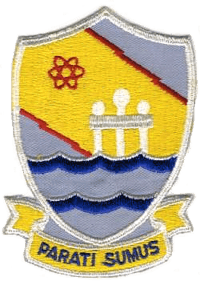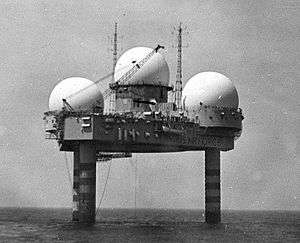Texas Tower 4
Texas Tower 4 | |
|---|---|
| Part of Air Defense Command (ADC) | |
|
Image of Texas Tower 4 | |
| Coordinates | 39°48′N 72°40′W / 39.800°N 72.667°WCoordinates: 39°48′N 72°40′W / 39.800°N 72.667°W |
| Type | Offshore air defense radar |
| Site history | |
| Built by |
|
| In use | 1958–1961 |
| Materials | Steel |
| Events | Collapsed January 15, 1961 |
| Garrison information | |
| Past commanders | Gordon (Larry) T. Phelan |


Texas Tower 4 (ADC ID: TT-4) was a former United States Air Force Texas Tower General Surveillance Radar station, located 63 miles (101 km) south-southwest off the coast of Long Island, New York in 185 feet (56 m) of water.[1] The tower was the site of a tragic accident and was destroyed by a winter storm on January 15, 1961. None of the twenty-eight airmen and civilian contractors who were manning the station survived.[2]
Texas Tower 4 was one in a series of manned radar stations that were so named because they resembled the oil-drilling platforms of the Gulf of Mexico. Air Defense Command (ADC) estimated that the Texas Towers would help extend contiguous East Coast radar coverage some 300 to 500 miles seaward. In terms of Soviet military capabilities, this would provide the United States with an extra 30 minutes of warning time in the event of an incoming bomber attack.
History
Early History
Texas Tower 4 began construction in December 1956 in South Portland, Maine, after construction was awarded to J. Rich Steers, Inc. of New York City in collaboration with Morrison-Knudsen, Inc., of Boise, Idaho. On 28 June 1957, it was successfully floated and towed to its site and erected. During transportation 2 or 3 structural supports were dislodged in rough seas. The Air Force considered two options: whether to fix the problem before or after erecting the radar platform. The latter was chosen which affected the structural integrity of the platform.
In 1958 enough of the structure was complete that one AN/FPS-3 search radar and two AN/FPS-6 height finder radars developed by Air Force Rome Air Development Center [RADC] New York, were installed.
Usage
Personnel from the 646th Radar Squadron, stationed at Highlands Air Force Station, NJ performed the operational use of the tower. The 4604th Support Squadron (Texas Towers) at Otis AFB, MA provided logistical support. The Tower communicated with the Highlands Air Force Station via the AN/FRC-56 Tropospheric scatter communications system. Originally 70 personnel manned the station under the command of Lt. Col. Robert Cutler. Life aboard Texas Tower 4 was difficult. Both the structure and its crew suffered from the near-constant vibration caused by rotating radar antennas and diesel generators. The surrounding ocean and tower footings also transmitted distant sounds along the steel legs, amplifying them throughout the entire structure.
By early 1961 the crew had been reduced to 14 Air Force personnel and 14 repairmen due to concerns over the inability of successive repairs crews to halt the movement of the structure. Prior to the collapse, the tower had weathered 2 cyclones over a 2-year period.
Collapse and investigation
Texas Tower 4 suffered severe structural damage during Hurricane Donna in September 1960 and, before repairs could be completed, was destroyed by a winter storm on January 15, 1961. None of the twenty-eight airmen and civilian contractors who were manning the station survived. Only two bodies were recovered.[2]
A Board of Inquiry was convened at Otis Air Force Base. By March 21, 1961, a Colonel, the acting commander of the Boston Air Defense sector, was charged with involuntary manslaughter and two other officers, commanding officer and executive officer of the 4604th Air Support Squadron, were charged with dereliction of duty.[3] Charges against the CO and XO were dropped in June 1961.[4] A court martial board dismissed all charges against the Colonel on August 24, 1961.[5]
In May 1961, hearings chaired by Senator John C. Stennis on the collapse of the tower were held before the Preparedness Investigating Subcommittee of the United States Senate Committee on Armed Services.[6] The committee concluded that human error, on the part of engineers, building contractors, the Air Force and the Navy, was responsible for the accident. The Navy was mentioned for its supervision of the construction and repair of the tower.[7]
Current status
Today the wreckage of TT-4 remains at the bottom of the ocean, and has become a site for scuba diving. Its depth, however, limits access to the wreckage to advanced divers.
The Museum of New Jersey Maritime History, located in Beach Haven, NJ, currently hosts the largest public collection of artifacts recovered from TT-4.
The site is also the location of a National Oceanic and Atmospheric Administration buoy.[8]
Units and assignments
Units:
- 646th Radar Squadron (Flight), (Operations unit based at Highlands AFS, NJ), 1 April 1959 – 15 January 1961
- 4604th Support Squadron (Texas Towers) (Logistics support unit based at Otis AFB, MA), 1 April 1959 – 15 January 1961
Assignments:
- Boston Air Defense Sector, 1 April 1959 – 15 January 1961
See also
References
![]() This article incorporates public domain material from the Air Force Historical Research Agency website http://www.afhra.af.mil/.
This article incorporates public domain material from the Air Force Historical Research Agency website http://www.afhra.af.mil/.
- ↑ "The locations". thetexastowers.com. Archived from the original on 2011-07-25.
- 1 2 Southall, Ashley, "Obama Recognizes Men Who Died in the Collapse of a Radar Tower in 1961", New York Times, 9 February 2011; retrieved 14 February 2011.
- ↑ "Colonel Charged in Texas Tower Fall Fatal to 28". Sarasota Journal. March 22, 1961.
- ↑ "Blame laid to Colonel". The Sumter Daily Item. June 10, 1961.
- ↑ "Court Martial Acquits Banks". The Evening News. August 24, 1961.
- ↑ United States Senate Committee on Armed Services (1961). Inquiry into the Collapse of Texas Tower No. 4 (PDF). United States Government Printing Office.
- ↑ "Texas Tower Tragedy is blamed on Human Error". Sarasota Herald-Tribune. April 1, 1962.
- ↑ "Station 44066 – Texas Tower #4 – 75 NM East of Long Beach, NJ". National Oceanic and Atmospheric Administration. Retrieved 16 January 2014.
- Winkler, David F. (1997), Searching the skies: the legacy of the United States Cold War defense radar program. Prepared for United States Air Force Headquarters Air Combat Command.
- A Handbook of Aerospace Defense Organization 1946–1980, by Lloyd H. Cornett and Mildred W. Johnson, Office of History, Aerospace Defense Center, Peterson Air Force Base, Colorado
- Information for Texas Tower No.4 (Unnamed Shoal)
- The Texas Towers
External links
- Gallery of the construction of the tower
- "Analysis on the collapse of Texas Tower 4" (PDF). Offshore Technology Conference. 2002. Archived from the original (PDF) on 2014-07-03.

